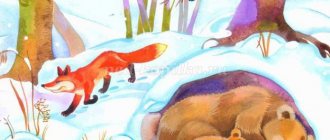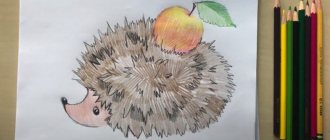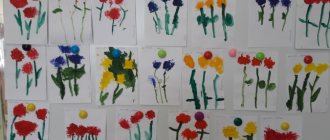Exciting activities for children aged 3 to 4 years in drawing with colored pencils, gouache and watercolors in traditional and non-traditional ways develop aesthetic perception. Kindergarten is the best place for developing emotional responsiveness, cultivating a sense of beauty, developing imagination, independence, perseverance, accuracy, hard work, and developing visual skills.
Fine arts lesson on the topic “Planes are flying” in junior kindergarten groups
Before preparing a lesson for children in the younger groups of kindergarten, you need to choose an interesting topic. In the process of visual activity, children must reflect life impressions. Drawing in the second junior group “Planes are flying” teaches you to depict objects and phenomena that form clear ideas about the environment.
Fine art lesson on the topic “Planes are flying” for younger groups
Example of drawing lesson notes
The program content should contain children's material, which must be conveyed in a drawing, reflecting the phenomena of modern life. Kids can draw airplanes flying in the sky. In addition, children should learn to draw straight lines in different directions when drawing objects related to flight. This technique contributes to the development of aesthetic perception.
Preview:
Summary of drawing lessons for young children
"Road for Cars"
1. Exercise children in the ability to draw a straight line without lifting the brush from the sheet.
2. Develop fine motor skills of the hands.
3. Cultivate accuracy when working with gouache.
Materials: brushes, jars of paint, jars of water, napkins for each child; three toy cars, a finished sample drawn; pattern with one stripe, pattern with two stripes.
Educator: Guys, cars came to visit us today, they are magical and came to us from a magical land. (shows three small cars).
Guys, look at the cars and tell me what kind of cars they are? (cars) and this? (freight)
-What color are they?
- What does the car have? (wheels, body, headlights, doors, windows, steering wheel, windshield, mirrors)
Let's show our cars how we can do (physical education minute):
To drive a car, we need to pump up the tires (simulation of movement with the sound shhhhh)
Pour gasoline into the gas tank (simulation of movement)
And let's go to the store (“travel” around the room)
Educator: Guys, do you know that our cars are very sad and upset! Do you know why? Yes, because they were driving towards us along a bad road. The road was full of holes, ditches and mounds! They almost broke down, and they still had to return home, so they were sad. Let us draw the cars a new smooth, smooth and colorful road.
Educator: Now, we sit down at our tables, but no one takes anything, you need to listen carefully to how we are going to draw so that it turns out correctly and only after I say loudly: DRAW, you will start drawing. Agreed?
— You have brushes, paints, jars of water and napkins on your tables. Now each of you will draw a part of the road, evenly and neatly, then we will let the drawing dry and collect our drawings into one long and beautiful road and show it to the cars, imagine how happy they will be. Look how I drew my path. To draw yours, you need to draw one line from top to bottom, then a second one and paint over the middle.
- Now, let’s pick up the brushes correctly (the teacher shows how to do it and looks at how the children are holding it; if it’s wrong, he corrects it). DRAW (speaks loudly) The children begin to draw, and the teacher draws with them again from the very beginning and says: first, from top to bottom, one line (sees how the children do it, then not far away the second line (looks at the children) and paint over (the teacher goes in rows to control the children's process, directing or correcting, or praising the children who are correct).
As the drawings are completed, the teacher takes the children's work to dry, praises each child and thanks them for their help on behalf of the machines.
- Well done guys, you tried very hard, the cars are happy and happy.
Source of the article: https://nsportal.ru/detskiy-sad/risovanie/2020/09/22/konspekt-zanyatiya-po-risovaniyu-s-detmi-rannego-vozrasta-doroga
Lesson Objectives
The main task is to form a self-sufficient, multifaceted, creative personality. Drawing for the 2nd junior group “Planes are flying” promotes the development of creative and cognitive activity and the enrichment of new knowledge. The child begins to get acquainted with the world around him.
Important! If you use non-standard materials and techniques, then you can easily interest children in visual arts. This method turns the process into an interesting hobby.
Airplane drawing problems
Educational tasks:
- develop the ability to listen carefully to the teacher’s explanation;
- cultivate positive emotions from classes and free motor activity;
- develop the ability to interact and establish contacts with adults and each other through speech;
- cultivate interest in drawing and evoke an emotional response.
Developmental tasks:
- develop the ability to independently and at the request of an adult take part in conversations;
- increase curiosity and cognitive interest in transport objects;
- develop fine motor skills, auditory perception, clarify and consolidate the articulation of the sound “u”;
- promote the development of skills in expressive and emotional transmission of game images.
On the topic: methodological developments, presentations and notes
Goal: to develop in children a sense of caring, responsible attitude towards nature. Tasks: v teach children to filter water; v teach children to plant seeds in beans; v reinforce the rules of behavior in.
Goal: consolidation and expansion of ideas about the vowel sounds “A”, “O”, “U”, “I”, “E”. Tasks:v consolidate the ability to determine position.
Summary of organized educational activities in the educational field “Artistic and aesthetic development” “Drawing” for younger children.
Children gain knowledge, skills, and abilities through gaming activities.
In direct educational activities, children acquire practical knowledge and skills in making birdhouses.
Summary of direct educational activities on artistic and aesthetic development (design) for children of senior preschool age Topic: “Bow for Cinderella.”
Summary of direct educational activities on artistic and aesthetic development (drawing) for children of senior preschool age Topic: “Maple leaves.”
Source of the article: https://nsportal.ru/detskiy-sad/risovanie/2018/01/21/narisuem-dorogu-dlya-mashiny-konspekt-obrazovatelnoy-deyatelnosti
Materials and equipment needed for the lesson
Materials and equipment to perform the work
For the lesson to go perfectly, you need to select a sheet of light blue paper, light gray gouache paints, brushes, jars of water, paper and cloth napkins, an easel, a toy aircraft, pictures of an airliner, a poster with flying planes.
Two toy airplanes are suitable as demonstration material.
For your information! From the handouts, it is recommended to prepare a large sheet of paper on which the flight of an airliner is depicted.
Progress of the lesson:
So that I can take you
I don't need oats.
Feed me gasoline
Give me rubber for my hooves,
And then, raising dust,
He will run. ( Automobile )
.
- That's right, this is a car . Have you seen how many cars are on the streets of our city? And they are all different. What cars did you see on the way to kindergarten? (Children's answers)
.
-What color are they?
There are different cars -
Blue and red
The tires rustle loudly,
They are in a hurry to go to kindergarten.
— One of the cars came to us for a lesson (showing a toy)
. Let's look at it. What colour is he? What parts does it consist of?
- Let's try to draw a car . But every driver wants his car to be special. He chooses a car of the color he likes. (Ask the children what color they want to paint their car ).
a drawing of a car on your tables . You will carefully paint them with your favorite color and draw wheels. And then our car will be able to drive along the city street.
— See how to carefully paint a car . Mine will be red. I take the brush by the iron skirt, wet it in water, then pick up paint, and remove excess paint on the edge of the can. I move the brush along the drawn line without lifting it from the sheet. I carefully paint the car . I rinse the brush in the jar and dry it on a napkin. I take black paint on a brush, trace the outline of the wheels and paint over them.
- Let's take brushes and try to trace the contour of the car .
- Now choose the paint that you need for your car .
Independent work of children (the teacher provides individual assistance.)
At the end of the lesson, the children's drawings are placed on a pre-prepared image of a city street . Together with the children, the teacher examines the drawings and notes their careful execution.
Preliminary work with children, discussion of the topic
At the first stage, the image of the aircraft is examined, the idea of the features of the appearance of the airliner (flying in the sky, through the air) is clarified. In addition, it is possible to sculpt an airplane and read a fairy tale.
Demonstration of materials
Which image to choose for printing on paper
Before choosing a sample to put on paper, the teacher introduces the children to the world of art. This method serves to develop a basic understanding of works of decorative and applied art and architecture. The teacher invites the kids to look at the template - an airplane.
Everything about preparing children for school on your own
Notes on drawing in the second junior group “Transport. Multi-colored cars"
Kozhenkova
Notes on drawing in the second junior group “Transport. Multi-colored cars"
A review of drawing in the second junior group on the topic : “ Transport .” ( Colorful cars )
.
Goal: to consolidate knowledge of colors, the ability to hold a brush correctly, and apply paint to a brush. To develop independence and accuracy in working with paints. Teach children how to paint an object correctly, without going beyond the outline, and choose the paint color on their own.
— contour drawings of cars;
Looking at illustrations, reading fiction about different types of transport , riddles about cars.
The teacher suggests looking at a picture of a truck and a gazelle, using their example to study the main parts of the car .
Questions for children based on their drawings
At the end of the lesson, the teacher can ask the children questions to reinforce the material:
- Children, what did you draw?
- How did you draw airplanes?
- Did you like drawing the plane?
The teacher asks questions to the children based on their drawings
When creating a drawing, kids should imagine the surrounding objective world. And thematic lessons play an important role in this. Drawing on the theme “Planes are flying” is an excellent choice for developing imagination and increasing children’s interest. The main thing is to praise the young artists at the end of the lesson, even if they didn’t do everything right.
Summary of drawing lesson “Transport. Types of transport" (in the 1st junior group)
MADOU No. 4 “Combined kindergarten”
Kemerovo, Kemerovo region
Summary of drawing lesson “Transport. Types of transport"
in the 1st junior group.
Performed:
Teacher Roo E.O.
2016
Topic: “Transport. Types of transport".
Target:
Repetition of modes of transport. Drawing wheels on a trailer using a stamp.
Tasks:
- Expand knowledge about the size of vehicles (large, small), and also name trucks, cars, buses, trams and main parts: cabin, steering wheel, body.
— Teach how to use paints and stamps, do the work carefully and correctly.
— Develop fine motor skills.
— Develop creative thinking and interest.
— Consolidate knowledge about color.
Material for the lesson
(demonstration and handout material):
- Whatman paper;
— toy cars (cars, trucks);
— pictures with a bus, tram, trolleybus.
— Blanks for drawing (cars from a steam locomotive);
— Stamps (bottle caps with fabric glued on a flat, round surface);
— Musical accompaniment (sound of cars, song “Locomotive”).
Progress of the lesson:
The sound of cars is heard. A truck pulls in, and Vaska the cat is on it.
Educator: - Listen, guys, someone is coming to us... Yes, it’s Vaska the cat in a car. Hello Vaska!
Vaska the cat: - Hello kids. I came to you in a truck and want to tell you about cars. They come in big and small, and all cars have a steering wheel, wheels, seats (I demonstrate this on toys, the children watch carefully).
— Check, do all cars have a steering wheel and wheels? (Children's answers).
— What should a car have so that the driver can get into it? (Children's answers).
- That's right, they have a door. What sound do we hear when the door opens? (Zipper)
Educator: - Guys, look what Vaska the cat brought us.
Vaska the cat: - This is a magic envelope, let's see what's in it. (opens and takes out a picture of a train).
- What is this? (Children's answers)
- That's right, it's a train. And now you and I will go on a journey on a train, we all get up one after another and go... (to the song “The Train”).
Educator: - Vaska the cat gave us a magic train, but what does the locomotive pull behind it?
— That’s right, trailers (I show a picture of a trailer without wheels)
— What is missing from the trailer? (Children’s answer: wheels)
- That's right, guys. Let's help the trailer find its wheels.
Children sit at the table, each with a trailer of a different color.
Educator: “What color are the trailers?” he asks the children. The children answer.
— What is missing from the trailers? (wheels).
- Let's draw wheels.
Practical part:
Educator: - We take the stamps in our hands and dip them in paint.




